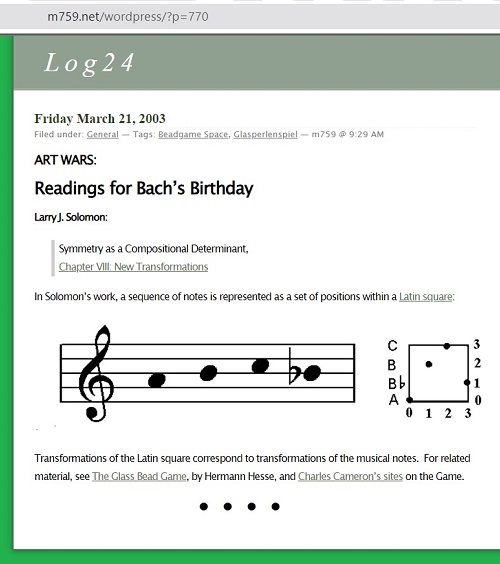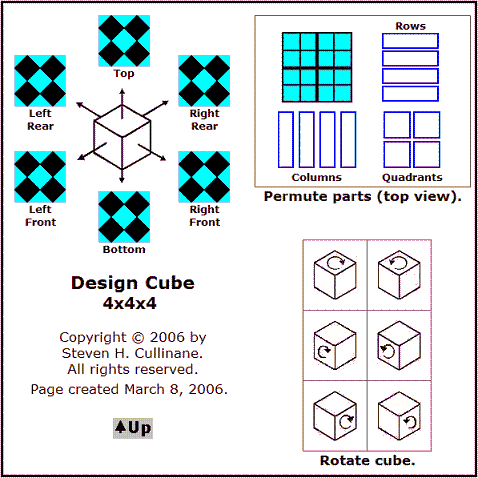Saturday, April 5, 2025
The previous post suggests a review of what might,
fancifully, be called the Indiana Langdon version
of the classic "duplication of the cube" problem.

In this version, the problem is to duplicate the static image
above as a rotatable 3D "diamond theorem unit cube" that
illustrates a design from 1984.
Comments Off on Fanciful Logic

View rotatable cube at https://3dthis.com/player.htm?h=LTk5ODY3NzQ .
I discovered the 3dthis site only yesterday. If I use it again, the results will
be at https://3dthis.com/profile.htm?owner=Cullinane.
For other such "photo cube" results at the site, see
https://3dthis.com/overview.htm?app=photocube&cat=all&order=date&start=0 .
To create such a cube at 3dthis, see https://3dthis.com/photocube.htm .
There is a "Resources for developers" page at
https://3dthis.com/developers.htm .
For some background on the Diamond Theorem Unit Cube, see
http://m759.net/wordpress/?s="Diamonds+and+Whirls".
Update of 2:30 PM EDT April 5 —

Comments Off on Diamond Theorem Unit Cube
Monday, September 23, 2024



Publisher (click to enlarge) —

See also a Google machine translation of the article to English.
Comments Off on Design History for a Guy Fawkes Day
Thursday, February 22, 2024
Comments Off on Symmetry Summary: The Cullinane Cube
Wednesday, February 14, 2024

From a post on Trevanian in December 2005 —
"And we may see
the meadow in December,
icy white and crystalline."
— Johnny Mercer,
"Midnight Sun"
Comments Off on Truchet Tiles Meet Cullinane Cube
Wednesday, November 22, 2023

* Author of Jewel Box: Stories ( Erewhon Books, Oct. 24, 2023).
Comments Off on For E. Lily Yu* — Devs Setting
Sunday, November 19, 2023

Heinlein:
"Sharpie, we have condensed six dimensions into four,
then we either work by analogy into six, or we have to use math
that apparently nobody but Jake and my cousin Ed understands.
Unless you can think of some way to project six dimensions into three–
you seem to be smart at such projections."
I closed my eyes and thought hard. "Zebbie, I don't think it can be done.
Maybe Escher could have done it."

Escher’s Verbum

Solomon’s Cube
Comments Off on Six Dimensions
Wednesday, May 10, 2023

Douglas Hofstadter —
“… I realized that to me,
Gödel and Escher and Bach
were only shadows
cast in different directions by
some central solid essence.
I tried to reconstruct
the central object, and
came up with this book.”
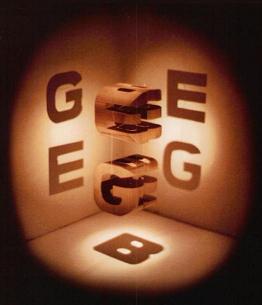
Related images —

Escher’s Verbum

Solomon’s Cube
Comments Off on Saving the Appearances
Thursday, April 20, 2023
Continued from April 18 .
"Working with words to create art
and working with your hands to create art
seem like two separate activities to me."
— Cover artist, The New Yorker , on April 17
See also Alphabet Blocks in this journal
as well as Escher's Verbum.
Comments Off on Alphabet Meets Gestalt . . .
Thursday, November 10, 2022



The above 1975 book by Robert Greer Cohn, Modes of Art, is
Volume I of a planned three-volume work.
The passage below is from a review of Cohn's Vol. II, Ways of Art —
|
Franklin, Ursula (1987) "Book Review: A Critical Work II.
Ways of Art: Literature. Music, Painting in France ,"
Grand Valley Review : Vol. 3: Iss. 1, Article 19. Available at: http://scholarworks.gvsu.edu/gvr/vol3/iss1/19 .
. . . .
Those not familiar with the author's epistemology should begin with Appendix A of Ways of Art , a schematic demonstration of his tetrapolar-polypolar-dialectic, especially as it concerns the development of the French novel within the European tradition. But this dialectic, which has antecedents in Kierkegaard, Mallarme and Joyce, underlies all art, because: "this dimensional pulsation, or tetrapolar (and polypolar) higher vibrancy is, in short, the stuff of life: life is vibrant in this more complex way as well as in the more bipolar sense" (7). Cohn shows that "far out enough" the male or linear and the female or circular, the male vertical and the female horizontal dimensions "tend to merge as in relativity theory" (19). Ways of Art shows us the way through a historical becoming of art in its complex dialectic in which the metonymic (horizontal) axis constantly interrelates with the metaphoric (vertical). "Life is the mother, art the father" (vii); hence Cohn's quarrel with most contemporary Feminism, which is pronounced throughout the volume. Firmly grounded in its author's tetra-polypolar epistemology, this beautiful book becomes, however, at no point dryly abstract; it is the mature work of a true humanist who stands in clear and open opposition to the dehumanizing trend of "the quasi-scientific reductionism and abstract gimmickry of a great deal of current academic literary study, bellwethered by the structuralists, post-structuralists, and deconstructionists" (vi). Abundant footnotes constitute a substantial part of Ways of Art , on occasion developing insights almost into essays demonstrating crucial points along the general flow of the tradition from "Obscure Beginnings;' the opening chapter, to our "Contemporaries;' the last.
Cohn reminds us that "In the Beginning was the Word;' for the Judaeo-Christian tradition at least, which his study fervently embraces; thus, for example, in Appendix 0 on "The Dance of the Sexes;' he censures "those who live by slogans, camps, and peer-opinion, the countless little bastard cults which characterize an era which has massively veered away from our free and beautiful Greco-Judaeo-Christian tradition" (332). Cohn traces man's way and that of his myths and rituals culminating in his art from that beginning along the lines of Freud, Neumann and Cassirer, and many others, always demonstrating the underlying polypolar dialectical rhythm. Thus in "From Barbarism to Young Culture;' we follow the Celts to Druidic ritual, Hebrew beginnings to the Psalms, Dionysian ritual to Greek tragedy, and thence to the beginnings of French dramatic literature originating in the Quem quaeritis sequence of the medieval Mass. Along the way arises artistic symbolism, for Cohn synonymous with "effective poetry;' to finally "ripen in France as never before" (99). Table I (134) graphs this development from the twelfth to the late nineteenth and early twentieth centuries. The author traces the rise of the artistic vocation from its antecedents in the double function of bard and priest, with the figure of Ronsard at the crossroads of that dying institution and the nascent concept of personal glory. "The Enlightenment Vocation" is exemplified in Montaigne, who humanizes the French cultural elite and points the way to French classicism and, farther down the road, after the moral collapse with the outgoing reign of Louis XIV, toward the Age of Reason. Clearly the most significant figure of the French Enlightenment for all of Western civilization is Rousseau, and Cohn beautifully shows us why this is so. Subsequently, "the nineteenth-century stage of the writer's journey will lead, starting from the crossroads of Rousseau, primarily in these two directions: the imperialistic and visionary prose of Balzac, the equally ambitious poetry of Mallarme", brothers under the skin" (199). And these two paths will then be reconciled in Proust's monumental A la recherche du temps perdu .
. . . .
|
Comments Off on For Students of the Forked Tongue
Monday, October 31, 2022
Folklore —

Earlier in that same journal . . .

Mathematics —

Comments Off on Folklore vs. Mathematics
Saturday, June 25, 2022
Comments Off on Gödel, Escher, Bach
Friday, May 6, 2022
WIkipedia on the URL suffix ".io" —
"In computer science, "IO" or "I/O" is commonly used
as an abbreviation for input/output, which makes the
.io domain desirable for services that want to be
associated with technology. .io domains are often used
for open source projects, application programming
interfaces ("APIs"), startup companies, browser games,
and other online services."
An association with the Bead Game from a post of April 7, 2018 —
|

Glasperlenspiel passage quoted here in Summa Mythologica —
“"I suddenly realized that in the language, or at any rate
in the spirit of the Glass Bead Game, everything actually
was all-meaningful, that every symbol and combination of
symbols led not hither and yon, not to single examples,
experiments, and proofs, but into the center, the mystery
and innermost heart of the world, into primal knowledge.
Every transition from major to minor in a sonata, every
transformation of a myth or a religious cult, every classical
or artistic formulation was, I realized in that flashing moment,
if seen with a truly meditative mind, nothing but a direct route
into the interior of the cosmic mystery, where in the alternation
between inhaling and exhaling, between heaven and earth,
between Yin and Yang, holiness is forever being created.”
A less poetic meditation on the above 4x4x4 design cube —
"I saw that in the alternation between front and back,
between top and bottom, between left and right,
symmetry is forever being created."
See also a related remark by Lévi-Strauss in 1955:
"…three different readings become possible:
left to right, top to bottom, front to back."
|
The recent use by a startup company of the URL "interality.io" suggests
a fourth reading for the 1955 list of Lévi-Strauss — in and out —
i.e., inner and outer group automorphisms — from a 2011 post
on the birthday of T. S. Eliot :
A transformation:

Click on the picture for details.
Comments Off on Interality and the Bead Game
Thursday, March 5, 2020
Comments Off on Pythagorean Letter Meets Box of Chocolates
Monday, November 11, 2019

The misleading image at right above is from the cover of
an edition of Charles Williams's classic 1931 novel
Many Dimensions published in 1993 by Wm. B. Eerdmans.
Compare and constrast —

Cover of a book by Douglas Hofstadter

An Invariance of Symmetry
Comments Off on Time and Chance
Monday, September 9, 2019


See as well an obituary for Mrs. Wertham from 1987.
Related art —
For further details, search the Web for "Wertham Professor" + Eck.
Comments Off on ART WARS at Harvard: The Wertham Professorship
Sunday, July 15, 2018

"… Lincoln Plaza Cinemas, the Juilliard String Quartet,
and the Strand Book Store remained oases
for cultural and intellectual stimulation."
— John S. Friedman in The Forward , Jan. 21, 2018
Read more:
https://forward.com/culture/392483/
how-fred-bass-dan-talbot-robert-mann
-shaped-new-york-culture/
From the Oasis in Steven Spielberg's "Ready Player One" (2018) —

I prefer, from a Log24 search for Flux Capacitor …

From "Raiders of the Lost Images" —
"The cube shape of the lost Mother Box,
also known as the Change Engine,
is shared by the Stone in a novel by
Charles Williams, Many Dimensions .
See the Solomon's Cube webpage."
Comments Off on Jewish Oases
Thursday, June 7, 2018


See also Eightfold Trinity in this journal.

Comments Off on For Dan Brown
Saturday, May 19, 2018
For Tom Hanks and Dan Brown —

From "Raiders of the Lost Images" —
"The cube shape of the lost Mother Box,
also known as the Change Engine,
is shared by the Stone in a novel by
Charles Williams, Many Dimensions .
See the Solomon's Cube webpage."
See as well a Google search for flux philosophy —
https://www.google.com/search?q=flux+philosophy.
Comments Off on Flux Capacitor
Saturday, April 7, 2018
The FBI holding cube in "The Blacklist" —

" 'The Front' is not the whole story . . . ."
— Vincent Canby, New York Times film review, 1976,
as quoted in Wikipedia.
See also Solomon's Cube in this journal.


Some may view the above web page as illustrating the
Glasperlenspiel passage quoted here in Summa Mythologica —
“"I suddenly realized that in the language, or at any rate
in the spirit of the Glass Bead Game, everything actually
was all-meaningful, that every symbol and combination of
symbols led not hither and yon, not to single examples,
experiments, and proofs, but into the center, the mystery
and innermost heart of the world, into primal knowledge.
Every transition from major to minor in a sonata, every
transformation of a myth or a religious cult, every classical
or artistic formulation was, I realized in that flashing moment,
if seen with a truly meditative mind, nothing but a direct route
into the interior of the cosmic mystery, where in the alternation
between inhaling and exhaling, between heaven and earth,
between Yin and Yang, holiness is forever being created.”
A less poetic meditation on the above 4x4x4 design cube —
"I saw that in the alternation between front and back,
between top and bottom, between left and right,
symmetry is forever being created."
See also a related remark by Lévi-Strauss in 1955:
"…three different readings become possible:
left to right, top to bottom, front to back."
Comments Off on Sides
Thursday, March 22, 2018
The Java applets at the webpage "Diamonds and Whirls"
that illustrate Cullinane cubes may be difficult to display.
Here instead is an animated GIF that shows the basic unit
for the "design cube" pages at finitegeometry.org.

Comments Off on The Diamond Cube
Tuesday, January 16, 2018

Other intersection-points-counting material —
The Finkelstein Talisman:

See also Hanks + Cube in this journal —
 .
.
Comments Off on The Pentagram Papers
Thursday, December 21, 2017
A review —

Some context —

Comments Off on For Winter Solstice 2017
Monday, July 24, 2017
The above title was suggested by a film trailer quoted here Saturday —
" Jeremy Irons' dry Alfred Pennyworth:
'One misses the days when one's biggest concerns
were exploding wind-up penguins.' "
"Penguin Classics Deluxe Edition" describes, among other books,
an edition of the I Ching published on December 1, 2015.
Excerpt from this journal on that date —
|
Tuesday, December 1, 2015
Filed under: Uncategorized — m759 @ 9:00 PM
(Continued)
"The positional meaning of a symbol derives from
its relationship to other symbols in a totality, a Gestalt,
whose elements acquire their significance from the
system as a whole."
— Victor Turner, The Forest of Symbols , Ithaca, NY,
Cornell University Press, 1967, p. 51, quoted by
Beth Barrie in "Victor Turner."
(Turner pioneered the use of the term "symbology,"
a term later applied by Dan Brown to a fictional
scholarly pursuit at Harvard.)
. . . .
|
Related material —


Comments Off on Penguin Classics Deluxe Edition
Thursday, June 22, 2017
With a hat tip to Vinnie Mancuso —


Comments Off on Face Henge
Wednesday, June 21, 2017
Remark on conceptual art quoted in the previous post —
"…he’s giving the concept but not the realization."
A concept — See a note from this date in 1983:

A realization —

Not the best possible realization, but enough for proof of concept .
Comments Off on Concept and Realization
Wednesday, March 29, 2017
Another view of the previous post's art space —

More generally, see Solomon's Cube in Log24.
See also a remark from Stack Exchange in yesterday's post Backstory,
and the Stack Exchange math logo below, which recalls the above
cube arrangement from "Affine groups on small binary spaces" (1984).
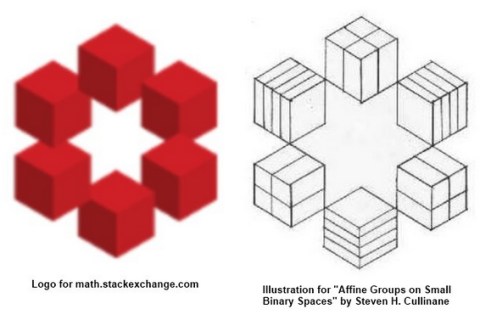
Comments Off on Art Space Illustrated
Friday, March 10, 2017
Or: Y for Yale continued

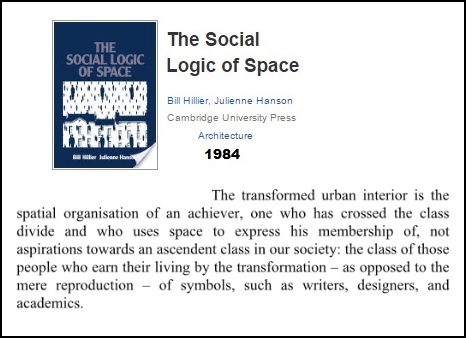
See also Transformers in this journal and Y for Yale.
Comments Off on Transformers
Thursday, March 2, 2017
"We tell ourselves stories in order to live." — Joan Didion
The New York Times Magazine online today —

"As a former believer and now a nonbeliever, Carrère,
seeking answers, sets out, in The Kingdom , to tell
the story of the storytellers. He is trying to understand
what it takes to be able to tell a story, any story.
And what he finds, once again, is that you have to find
your role in it."
— Wyatt Mason in The New York Times Magazine ,
online March 2, 2017
Like Tom Hanks?

Click image for related posts.
Comments Off on Stories
Sunday, February 26, 2017
Transformations acting on Solomon's Cube
furnish a model of poetic order.
Some backstory for Hollywood —


Comments Off on Poetic Order
Saturday, February 18, 2017
See Hanks + Cube in this journal … For instance …
Comments Off on Solid Symmetry (continued)
The Log24 version (Nov. 9, 2005, and later posts) —
The Warner Brothers version —

The Paramount version —

See also related material in the previous post, Transformers.
Comments Off on Verbum
Monday, October 3, 2016
Friday, August 5, 2016
From an earlier Log24 post —
From a post of the next day, July 12, 2014 —

"So there are several different genres and tones
jostling for prominence within Lexicon :
a conspiracy thriller, an almost abstract debate
about what language can do, and an ironic
questioning of some of the things it’s currently used for."
— Graham Sleight in The Washington Post
a year earlier, on July 15, 2013
For the Church of Synchronology, from Log24 on the next day —

From a post titled Circles on the date of Marc Simont's death —

See as well Verhexung in this journal.
Comments Off on Sleight of Post
Thursday, July 14, 2016
The title is that of a large-scale British research project
in mathematics. On a more modest scale …
"Hanks + Cube" in this journal —

Block That Metaphor —

Comments Off on Symmetries and Correspondences
Tuesday, June 21, 2016
“The central poem is the poem of the whole,
The poem of the composition of the whole”
— Wallace Stevens, “A Primitive like an Orb”
The symmetries of the central four squares in any pattern
from the 4×4 version of the diamond theorem extend to
symmetries of the entire pattern. This is true also of the
central eight cubes in the 4×4×4 Solomon’s cube .

Comments Off on The Central Structure
Tuesday, May 3, 2016
A note related to the diamond theorem and to the site
Finite Geometry of the Square and Cube —
The last link in the previous post leads to a post of last October whose
final link leads, in turn, to a 2009 post titled Summa Mythologica .

Some may view the above web page as illustrating the
Glasperlenspiel passage quoted here in Summa Mythologica —
“"I suddenly realized that in the language, or at any rate
in the spirit of the Glass Bead Game, everything actually
was all-meaningful, that every symbol and combination of
symbols led not hither and yon, not to single examples,
experiments, and proofs, but into the center, the mystery
and innermost heart of the world, into primal knowledge.
Every transition from major to minor in a sonata, every
transformation of a myth or a religious cult, every classical
or artistic formulation was, I realized in that flashing moment,
if seen with a truly meditative mind, nothing but a direct route
into the interior of the cosmic mystery, where in the alternation
between inhaling and exhaling, between heaven and earth,
between Yin and Yang, holiness is forever being created.”
A less poetic meditation on the above web page* —
"I saw that in the alternation between front and back,
between top and bottom, between left and right,
symmetry is forever being created."
Update of Sept. 5, 2016 — See also a related remark
by Lévi-Strauss in 1955: "…three different readings
become possible: left to right, top to bottom, front
to back."
* For the underlying mathematics, see a June 21, 1983, research note.
Comments Off on Symmetry
Wednesday, April 20, 2016
The reference in the previous post to the work of Guitart and
The Road to Universal Logic suggests a fiction involving
the symmetric generation of the simple group of order 168.
See The Diamond Archetype and a fictional account of the road to Hell …

The cover illustration below has been adapted to
replace the flames of PyrE with the eightfold cube.

For related symmetric generation of a much larger group, see Solomon’s Cube.
Comments Off on Symmetric Generation of a Simple Group
Monday, April 4, 2016
Foreword by Sir Michael Atiyah —
"Poincaré said that science is no more a collection of facts
than a house is a collection of bricks. The facts have to be
ordered or structured, they have to fit a theory, a construct
(often mathematical) in the human mind. . . .
… Mathematics may be art, but to the general public it is
a black art, more akin to magic and mystery. This presents
a constant challenge to the mathematical community: to
explain how art fits into our subject and what we mean by beauty.
In attempting to bridge this divide I have always found that
architecture is the best of the arts to compare with mathematics.
The analogy between the two subjects is not hard to describe
and enables abstract ideas to be exemplified by bricks and mortar,
in the spirit of the Poincaré quotation I used earlier."
— Sir Michael Atiyah, "The Art of Mathematics"
in the AMS Notices , January 2010
Judy Bass, Los Angeles Times , March 12, 1989 —
"Like Rubik's Cube, The Eight demands to be pondered."
As does a figure from 1984, Cullinane's Cube —

For natural group actions on the Cullinane cube,
see "The Eightfold Cube" and
"A Simple Reflection Group of Order 168."
See also the recent post Cube Bricks 1984 —

Related remark from the literature —

Note that only the static structure is described by Felsner, not the
168 group actions discussed by Cullinane. For remarks on such
group actions in the literature, see "Cube Space, 1984-2003."
(From Anatomy of a Cube, Sept. 18, 2011.)
Comments Off on Cube for Berlin
Wednesday, December 2, 2015

Click image to search Log24
for Solomon + Stone.
Comments Off on Symbology
Saturday, April 25, 2015
For Poetry Month
From the home page of Alexandre Borovik:
Book in progress: Shadows of the Truth
This book (to be published soon) can be viewed
as a sequel to Mathematics under the Microscope ,
but with focus shifted on mathematics as it was
experienced by children (well, by children who
became mathematicians). The cover is designed
by Edmund Harriss.

See also Harriss's weblog post of Dec. 27, 2008, on the death
of Harold Pinter: "The Search for the Truth Can Never Stop."
This suggests a review of my own post of Dec. 3, 2012,
"The Revisiting." A figure from that post:

Comments Off on Ghosts and Shadows
Wednesday, September 17, 2014
Tom Hanks as Indiana Langdon in Raiders of the Lost Articulation :
An unarticulated (but colored) cube:

A 2x2x2 articulated cube:

A 4x4x4 articulated cube built from subcubes like
the one viewed by Tom Hanks above:

Solomon’s Cube
Comments Off on Raiders of the Lost Articulation
Saturday, July 12, 2014
For Ursula K. Le Guin

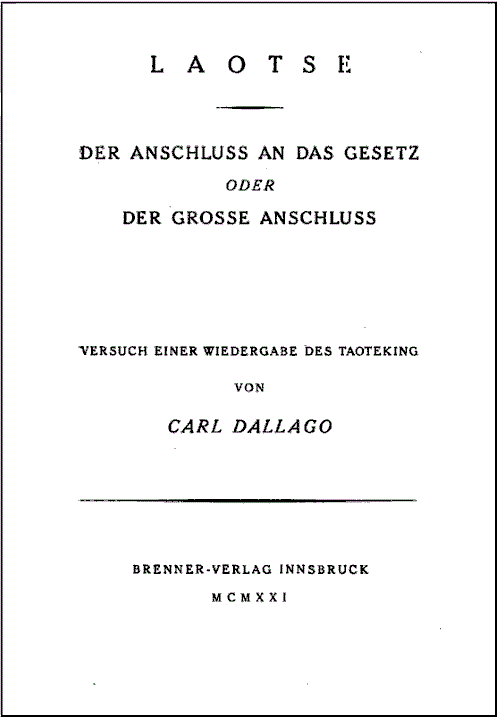

“For me it is a sign that we have fundamentally different
conceptions of the work of the intelligence services.”
— Germany’s Chancellor Angela Merkel in
theguardian.com, Saturday, 12 July 2014, 14.32 EDT
Another sort of service, thanks to Dan Brown and Tom Hanks:
Comments Off on Mars Package
A sequel to the 1974 film
Thunderbolt and Lightfoot :
Contingent and Fluky
Some variations on a thunderbolt theme:

These variations also exemplify the larger
Verbum theme:

Escher’s Verbum

Solomon’s Cube
A search today for Verbum in this journal yielded
a Georgetown University Chomskyite, Professor
David W. Lightfoot.
"Dr. Lightfoot writes mainly on syntactic theory,
language acquisition and historical change, which
he views as intimately related. He argues that
internal language change is contingent and fluky,
takes place in a sequence of bursts, and is best
viewed as the cumulative effect of changes in
individual grammars, where a grammar is a
'language organ' represented in a person's
mind/brain and embodying his/her language
faculty."
Some syntactic work by another contingent and fluky author
is related to the visual patterns illustrated above.
See Tecumseh Fitch in this journal.
For other material related to the large Verbum cube,
see posts for the 18th birthday of Harry Potter.
That birthday was also the upload date for the following:
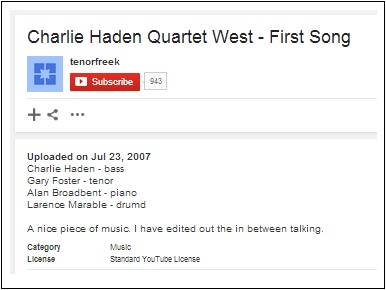
See esp. the comments section.
Comments Off on Sequel
Friday, July 11, 2014
Comments Off on Spiegel-Spiel des Gevierts
Friday, May 9, 2014
“The About page contains detailed descriptions of the project….”
— The Illustris project on constructing a model of the universe
For the mathematics of a simpler traditional Chinese model
of everything, see
Comments Off on Models of Everything
Thursday, March 27, 2014
(Continued)
Definition: A diamond space — informal phrase denoting
a subspace of AG(6, 2), the six-dimensional affine space
over the two-element Galois field.
The reason for the name:

Click to enlarge.
Comments Off on Diamond Space
Monday, November 5, 2012
Continued from April 2, 2012.
Some predecessors of the Cullinane design cubes of 1984
that lack the Cullinane cubes' symmetry properties—
Kohs cubes (see 1920 article)
Wechsler cubes (see Wechsler in this journal), and
Horowitz cubes (see links below).
Horowitz Design Cubes Package
Horowitz Design Cubes (1971)
1973 Horowitz Design Cubes Patent
Horowitz Biography
Comments Off on Design Cubes
Sunday, August 5, 2012
The second Logos figure in the previous post
summarized affine group actions on partitions
that generate a group of about 1.3 trillion
permutations of a 4x4x4 cube (shown below)—

Click for further details.
Comments Off on Cube Partitions
Thursday, July 26, 2012
(Mathematics and Narrative, continued)
Narrative—
The Ring and The Stone from yesterday's post, and…
"In Medieval Jewish, Christian and Islamic legends,
the Seal of Solomon was a magical signet ring
said to have been possessed by King Solomon…."
— Wikipedia article, Seal of Solomon
Mathematics—

A fact related to the mathematical
"Solomon's seal" described above by Bell:

The reference to Edge is as follows—
[3] Edge, W. L., Quadrics over GF(2) and
their relevance for the cubic surface group,
Canadian J. Maths. 11 (1959) ….
(This reference relates Hirschfeld's remarks
quoted above to the 64-point affine space
illustrated below (via the associated
63-point projective space PG (5, 2)).
As for the narrative's Stone…

Comments Off on Solomon’s Seal
Saturday, April 21, 2012

In "Contact," Dr. Arroway is shown the key to the Primer—

In this journal, fictional symbologist Robert Langdon is shown a cube—

"Confusion is nothing new." — Song lyric
Comments Off on Finding a Form
Wednesday, April 18, 2012
…. and John Golding, an authority on Cubism who "courted abstraction"—

"Adam in Eden was the father of Descartes." — Wallace Stevens
Fictional symbologist Robert Langdon and a cube—

From a Log24 post, "Eightfold Cube Revisited,"
on the date of Golding's death—

A related quotation—
"… quaternions provide a useful paradigm
for studying the phenomenon of 'triality.'"
— David A. Richter's webpage Zometool Triality
See also quaternions in another Log24 post
from the date of Golding's death— Easter Act.
Comments Off on Adam in Eden
Monday, April 16, 2012
Gary Gutting, "Arguing About Language," in "The Stone,"
The New York Times philosophy column, yesterday—
There's a sense in which we speak language
and a sense in which, in Mallarmé's famous phrase,
“language itself speaks.”
Famous? A Google Book Search for
"language itself speaks" Mallarmé
yields 2 results, neither helpful.
But a Google Book Search for
"language itself speaks" Heidegger
yields "about 312 results."
A related search yields the following—
Paul Valéry, encountering Un Coup de Dés in Mallarmé’s worksheets in 1897, described the text as tracing the pattern of thought itself:
It seemed to me that I was looking at the form and pattern of a thought, placed for the first time in finite space. Here space itself truly spoke, dreamed, and gave birth to temporal forms….
… there in the same void with them, like some new form of matter arranged in systems or masses or trailing lines, coexisted the Word! (Leonardo 309*)
* The page number is apparently a reference to The Collected Works of Paul Valéry: Leonardo, Poe, Mallarmé , translated by Malcolm Cowley and James R. Lawler, Princeton University Press, 1972. (As a temporal form, "309" might be interpreted as a reference to 3/09, March 9, the date of a webpage on the Void.)
For example—

Background:
Deconstructing Alice
and Symbology.
Comments Off on Carroll Thanks the Academy
Wednesday, January 11, 2012
"Examples galore of this feeling must have arisen in the minds of the people who extended the Magic Cube concept to other polyhedra, other dimensions, other ways of slicing. And once you have made or acquired a new 'cube'… you will want to know how to export a known algorithm , broken up into its fundamental operators , from a familiar cube. What is the essence of each operator? One senses a deep invariant lying somehow 'down underneath' it all, something that one can’t quite verbalize but that one recognizes so clearly and unmistakably in each new example, even though that example might violate some feature one had thought necessary up to that very moment. In fact, sometimes that violation is what makes you sure you’re seeing the same thing , because it reveals slippabilities you hadn’t sensed up till that time….
… example: There is clearly only one sensible 4 × 4 × 4 Magic Cube. It is the answer; it simply has the right spirit ."
— Douglas R. Hofstadter, 1985, Metamagical Themas: Questing for the Essence of Mind and Pattern (Kindle edition, locations 11557-11572)
See also Many Dimensions in this journal and Solomon's Cube.
Comments Off on Cuber
Wednesday, September 1, 2010
For Alyssa Milano —

The Forking
(Click here for cheesy Neil Diamond background music.)
For some related philosophical remarks, see Deconstructing Alice

and the new Pythagorean thriller The Thousand.
Comments Off on September Morn
Wednesday, June 16, 2010
David Levine's portrait of Arthur Koestler (see Dec. 30, 2009) —


Escher’s Verbum

Solomon’s Cube

Geometry of the I Ching
See also this morning's post as well as
Monday's post quoting George David Birkhoff —
"If I were a Leibnizian mystic… I would say that…
God thinks multi-dimensionally — that is,
uses multi-dimensional symbols beyond our grasp."
Comments Off on Brightness at Noon
(Continued from April 23, 2009, and February 13, 2010.)
Paul Valéry as quoted in yesterday’s post:
“The S[elf] is invariant, origin, locus or field, it’s a functional property of consciousness” (Cahiers, 15:170 [2: 315])
The geometric example discussed here yesterday as a Self symbol may seem too small to be really impressive. Here is a larger example from the Chinese, rather than European, tradition. It may be regarded as a way of representing the Galois field GF(64). (“Field” is a rather ambiguous term; here it does not, of course, mean what it did in the Valéry quotation.)
From Geometry of the I Ching—

The above 64 hexagrams may also be regarded as
the finite affine space AG(6,2)— a larger version
of the finite affine space AG(4,2) in yesterday’s post.
That smaller space has a group of 322,560 symmetries.
The larger hexagram space has a group of
1,290,157,424,640 affine symmetries.
From a paper on GL(6,2), the symmetry group
of the corresponding projective space PG(5,2),*
which has 1/64 as many symmetries—
(Click to enlarge.)

For some narrative in the European tradition
related to this geometry, see Solomon’s Cube.
* Update of July 29, 2011: The “PG(5,2)” above is a correction from an earlier error.
Comments Off on Geometry of Language
Tuesday, May 4, 2010
Romancing the
Non-Euclidean Hyperspace
Backstory —
Mere Geometry, Types of Ambiguity,
Dream Time, and Diamond Theory, 1937

For the 1937 grid, see Diamond Theory, 1937.
The grid is, as Mere Geometry points out, a non-Euclidean hyperspace.
For the diamonds of 2010, see Galois Geometry and Solomon’s Cube.
Comments Off on Mathematics and Narrative, continued
Friday, March 19, 2010
For Alyssa
An Old Magic Symbol

… and for Dan Brown —
Symbology

Comments Off on Garden of Forking Paths
Saturday, March 6, 2010
Alyssa is Wonderland
Manohla Dargis in The New York Times yesterday—
“Of course the character of Carroll’s original Alice is evident in each outrageous creation she dreams up in ‘Wonderland’ and in the sequel, ‘Through the Looking-Glass,’ which means that she’s a straight man to her own imagination. (She is Wonderland.)”
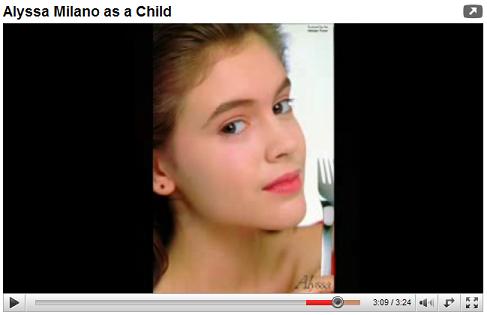
From Inside the White Cube—
“The sacramental nature of the space becomes clear, and so does one of the great projective laws of modernism: as modernism gets older, context becomes content. In a peculiar reversal, the object introduced into the gallery ‘frames’ the gallery and its laws.”
From Yogi Berra–
“When you come to a fork in the road, take it.”
Related material: For Baron Samedi and…
Symbology


Comments Off on Deconstructing Alice
Thursday, February 18, 2010
Truth, Geometry, Algebra
The following notes are related to A Simple Reflection Group of Order 168.
1. According to H.S.M. Coxeter and Richard J. Trudeau
“There is a pleasantly discursive treatment of Pontius Pilate’s unanswered question ‘What is truth?’.”
— Coxeter, 1987, introduction to Trudeau’s The Non-Euclidean Revolution
1.1 Trudeau’s Diamond Theory of Truth
1.2 Trudeau’s Story Theory of Truth
2. According to Alexandre Borovik and Steven H. Cullinane
2.1 Coxeter Theory according to Borovik
2.1.1 The Geometry–
Mirror Systems in Coxeter Theory
2.1.2 The Algebra–
Coxeter Languages in Coxeter Theory
2.2 Diamond Theory according to Cullinane
2.2.1 The Geometry–
Examples: Eightfold Cube and Solomon’s Cube
2.2.2 The Algebra–
Examples: Cullinane and (rather indirectly related) Gerhard Grams
Summary of the story thus far:
Diamond theory and Coxeter theory are to some extent analogous– both deal with reflection groups and both have a visual (i.e., geometric) side and a verbal (i.e., algebraic) side. Coxeter theory is of course highly developed on both sides. Diamond theory is, on the geometric side, currently restricted to examples in at most three Euclidean (and six binary) dimensions. On the algebraic side, it is woefully underdeveloped. For material related to the algebraic side, search the Web for generators+relations+”characteristic two” (or “2“) and for generators+relations+”GF(2)”. (This last search is the source of the Grams reference in 2.2.2 above.)
Comments Off on Theories: An Outline
Tuesday, January 26, 2010
From this journal:
Transition to the
Garden of Forking Paths–
(See For Baron Samedi)–
The Found Symbol

and Dissemination, by Jacques Derrida,
translated by Barbara Johnson,
London, Athlone Press, 1981–
Pages 354-355
On the mirror-play of the fourfold
Pages 356-357
Shaking up a whole culture
Pages 358-359
Cornerstone and crossroads
Pages 360-361
A deep impression embedded in stone
Pages 362-363
A certain Y, a certain V
Pages 364-365
The world is Zeus's play
Page 366
It was necessary to begin again
Comments Off on Symbology
Saturday, January 23, 2010
Yesterday's Times —

Today's Times —

Annals of Deconstruction —
Click on image for background.

Related material
for Baron Samedi —
The Found Symbol


Comments Off on For Baron Samedi
Saturday, November 14, 2009
A graphic novel reviewed in the current Washington Post features Alfred North Whitehead and Bertrand Russell–

Related material:
Whitehead on Fano's finite projective three-space:
"This is proved by the consideration of a three dimensional geometry in which there are only fifteen points."
—The Axioms of Projective Geometry , Cambridge University Press, 1906
A related affine six-space:

Further reading:
See Solomon's Cube and the link at the end of today's previous entry, then compare and contrast the above portraits of Whitehead and Russell with Charles Williams's portraits of Sir Giles Tumulty and Lord Arglay in the novel Many Dimensions .
"It was a dark and stormy night…."
Comments Off on Mathematics and Narrative, continued:
Thursday, October 22, 2009
From the Bulletin of the American Mathematical Society, Jan. 26, 2005:
What is known about unit cubes
by Chuanming Zong, Peking University
Abstract: Unit cubes, from any point of view, are among the simplest and the most important objects in n-dimensional Euclidean space. In fact, as one will see from this survey, they are not simple at all….
From Log24, now:
What is known about the 4×4×4 cube
by Steven H. Cullinane, unaffiliated
Abstract: The 4×4×4 cube, from one point of view, is among the simplest and the most important objects in n-dimensional binary space. In fact, as one will see from the links below, it is not simple at all.
Solomon's Cube
The Klein Correspondence, Penrose Space-Time, and a Finite Model
Non-Euclidean Blocks
Geometry of the I Ching
Related material:
Monday's entry Just Say NO and a poem by Stevens,
"The Well Dressed Man with a Beard."
Comments Off on Chinese Cubes
Thursday, September 17, 2009


“Nobody puts Baby in a corner.”
Comments Off on Thursday September 17, 2009
Wednesday, September 16, 2009
The Found Symbol

Comments Off on Wednesday September 16, 2009
Saturday, September 5, 2009
Comments Off on Saturday September 5, 2009
Saturday, May 10, 2008
MoMA Goes to
Kindergarten
"… the startling thesis of Mr. Brosterman's new book, 'Inventing Kindergarten' (Harry N. Abrams, $39.95): that everything the giants of modern art and architecture knew about abstraction they learned in kindergarten, thanks to building blocks and other educational toys designed by Friedrich Froebel, a German educator, who coined the term 'kindergarten' in the 1830's."
— "Was Modernism Born
in Toddler Toolboxes?"
by Trip Gabriel, New York Times,
April 10, 1997
RELATED MATERIAL
Figure 1 —
Concept from 1819:

(Footnotes 1 and 2)
Figure 2 —
The Third Gift, 1837:

Froebel's Third Gift
Froebel, the inventor of
kindergarten, worked as
an assistant to the
crystallographer Weiss
mentioned in Fig. 1.
(Footnote 3)
Figure 3 —
The Third Gift, 1906:

Figure 4 —
Solomon's Cube,
1981 and 1983:

Figure 5 —
Design Cube, 2006:
For some mathematical background, see
Footnotes:
Comments Off on Saturday May 10, 2008
Monday, July 23, 2007
Daniel Radcliffe
is 18 today.
Greetings.
“The greatest sorcerer (writes Novalis memorably)
would be the one who bewitched himself to the point of
taking his own phantasmagorias for autonomous apparitions.
Would not this be true of us?”
–Jorge Luis Borges, “Avatars of the Tortoise”
“El mayor hechicero (escribe memorablemente Novalis)
sería el que se hechizara hasta el punto de
tomar sus propias fantasmagorías por apariciones autónomas.
¿No sería este nuestro caso?”
–Jorge Luis Borges, “Los Avatares de la Tortuga“
Autonomous Apparition
At Midsummer Noon:
“In Many Dimensions (1931)
Williams sets before his reader the
mysterious Stone of King Solomon,
an image he probably drew from
a brief description in Waite’s
The Holy Kabbalah (1929) of
a supernatural cubic stone
on which was inscribed
‘the Divine Name.’”
Related material:
|
It is not enough to cover the rock with leaves.
We must be cured of it by a cure of the ground
Or a cure of ourselves, that is equal to a cure
Of the ground, a cure beyond forgetfulness.
And yet the leaves, if they broke into bud,
If they broke into bloom, if they bore fruit,
And if we ate the incipient colorings
Of their fresh culls might be a cure of the ground.
– Wallace Stevens, “The Rock”
|
See also
“… I realized that to me,
Gödel and Escher and Bach
were only shadows
cast in different directions by
some central solid essence.
I tried to reconstruct
the central object, and
came up with this book.”
 Hofstadter’s cover.
Hofstadter’s cover.
Here are three patterns,
“shadows” of a sort,
derived from a different
“central object”:
Click on image for details.
Comments Off on Monday July 23, 2007
Tuesday, April 3, 2007
Our Judeo-Christian
Heritage –
Lottery
Hermeneutics
Part II: Christian
Part III:
Imago Dei
Click on picture
for details.
Related material:
It is perhaps relevant to
this Holy Week that the
date 6/04 (2006) above
refers to both the Christian
holy day of Pentecost and
to the day of the
facetious baccalaureate
of the Class of 2006 in
the University Chapel
at Princeton.
For further context for the
Log24 remarks of that same
date, see June 1-15, 2006.
Comments Off on Tuesday April 3, 2007
Sunday, December 10, 2006
| The Lottery 12/9/06 |
Mid-day |
Evening |
| New York |
036
See
The Quest
for the 36 |
331
See 3/31—
“square crystal” and “the symbolism could not have been more perfect.” |
| Pennsylvania |
602
See 6/02—
Walter Benjamin
on
“Adamic language.” |
111
See 1/11—
“Related material:
Jung’s Imago and Solomon’s Cube.”
|
Comments Off on Sunday December 10, 2006
Thursday, October 5, 2006
In Touch with God
(Title of an interview with
the late Paul Halmos, mathematician)
Since Halmos died on Yom Kippur, his thoughts on God may be of interest to some.
From a 1990 interview:
“What’s the best part of being a mathematician? I’m not a religious man, but it’s almost like being in touch with God when you’re thinking about mathematics. God is keeping secrets from us, and it’s fun to try to learn some of the secrets.”
I personally prefer Annie Dillard on God:
“… if Holy the Firm is matter at its dullest, Aristotle’s materia prima, absolute zero, and since Holy the Firm is in touch with the Absolute at base, then the circle is unbroken. And it is…. Holy the Firm is in short the philosopher’s stone.”
Some other versions of
the philosopher’s stone:

And, more simply,
April 28, 2004:

This last has the virtue of
being connected with Halmos
via his remarks during the
“In Touch with God” interview:
“…at the root of all deep mathematics there is a combinatorial insight… the really original, really deep insights are always combinatorial….”
“Combinatorics, the finite case, is where the genuine, deep insight is.”
See also the remark of Halmos that serves as an epigraph to Theme and Variations.
Comments Off on Thursday October 5, 2006
Wednesday, July 5, 2006
And now, from
the author of Sphere…
CUBE
He beomes aware of something else… some other presence.
"Anybody here?" he says.
I am here.
He almost jumps, it is so loud. Or it seems loud. Then he wonders if he has heard anything at all.
"Did you speak?"
No.
How are we communicating? he wonders.
The way everything communicates with everything else.
Which way is that?
Why do you ask if you already know the answer?
— Sphere, by Michael Crichton, Harvard '64
"… when I went to Princeton things were completely different. This chapel, for instance– I remember when it was just a clearing, cordoned off with sharp sticks. Prayer was compulsory back then, and you couldn't just fake it by moving your lips; you had to know the words, and really mean them. I'm dating myself, but this was before Jesus Christ."
— Baccalaureate address at Princeton, Pentecost 2006, reprinted in The New Yorker, edited by David Remnick, Princeton '81
Comments Off on Wednesday July 5, 2006
Saturday, June 17, 2006
“Breaking the spell of religion is a
game that many people can play.”
— Freeman Dyson in the current
New York Review of Books
Part I:
The Game

Part II:
Many People

For further details,
see Solomon’s Cube
and myspace.com/affine.
“The rock cannot be broken.
It is the truth.”
— Wallace Stevens
Comments Off on Saturday June 17, 2006
Wednesday, May 10, 2006
“… we have condensed six dimensions into four, then we either work by analogy into six, or we have to use math that apparently nobody but Jake and my cousin Ed understands. Unless you can think of some way to project six dimensions into three– you seem to be smart at such projections.”
I closed my eyes and thought hard. “Zebbie, I don’t think it can be done. Maybe Escher could have done it.”
Comments Off on Wednesday May 10, 2006
Thursday, March 9, 2006
Finitegeometry.org Update
(Revised May 21, 2006)
Finitegeometry.org now has permutable JavaScript views of the 2x2x2 and 4x4x4 design cubes. Solomon’s Cube presented a claim that the 4x4x4 design cube retains symmetry under a group of about 1.3 trillion transformations. The JavaScript version at finitegeometry.org/sc/64/view/ lets the reader visually verify this claim. The reader should first try the Diamond 16 Puzzle. The simpler 2x2x2 design cube, with its 1,344 transformations, was described in Diamonds and Whirls; the permutable JavaScript version is at finitegeometry.org/sc/8/view/.
Comments Off on Thursday March 9, 2006
Wednesday, November 9, 2005
In honor of the 120th anniversary of the birth of Hermann Weyl:
Comments Off on Wednesday November 9, 2005




















